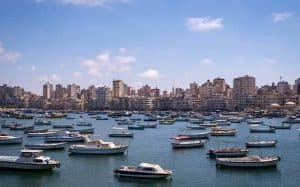Fierce Dragons, Fiercer Paddles: Get Pumped for Dragon Boat Racing

Updated On: April 22, 2024 by Yasmin Elwan
For centuries, dragon boat racing has been a vibrant part of Chinese culture. Its origins are as ancient as the rivers it takes place on, intertwining a tapestry of folklore, history, and communal spirit. The thundering drums, the competitive paddling, and the intricately designed boats define not just a sport but a traditional festival steeped in ritual and remembrance. At the heart of this tradition is the Dragon Boat Festival, an event that beautifully encapsulates the reverence for heritage and the timeless human love for festivity and competition.

Today, dragon boat racing is more than just a commemorative activity; it’s a global phenomenon that bridges cultures, embodying both competitive sport and cultural celebration. The festival occurs on the fifth day of the fifth lunar month, honouring the patriotic poet Qu Yuan, resonating with themes of loyalty and sacrifice. Communities come together to participate in the racing events, but also to partake in the various activities and foods associated with the celebration, like the making and sharing of zongzi— glutinous rice treats wrapped in bamboo leaves.
Historical Origins
The Dragon Boat Festival’s historical roots intertwine with commemorative practices and legend, echoing through China’s long and storied past.
Qu Yuan and the Warring States
Populating the Warring States Period, Qu Yuan was a respected poet and minister whose ill-fated protest against corruption led to his demise in the Miluo River. His patriotic sacrifice fundamentally shaped the Duanwu Festival’s inception, as communities began dragon boat races to honour his spirit.
The Legend of the Miluo River
The Miluo River, crystallising the collective memory of Qu Yuan’s loyalists, became legendary as locals fervidly paddled to retrieve his sunken body. This act of devotion birthed the ritualistic dragon boat races, symbolising the ceaseless search and hopes to protect Qu Yuan from harm.
Evolution of the Duanwu Festival
Over centuries, the Duanwu Festival has transcended its origins, morphing from a sombre remembrance into a vibrant cultural phenomenon. Embracing the historical spirit, the dragon boat races have flourished, becoming a testament to the resilience and evolving traditions of Chinese culture.
Cultural Significance of the Dragon Boat Racing

The Dragon Boat Festival, steeped in rich history, embodies the essence of Chinese cultural significance through its mythology, communal rituals, and age-old superstitions. It transcends mere festivity, becoming a potent symbol of unity and prosperity and a bulwark against malevolent forces.
Mythology and Symbolism
In Chinese culture, the dragon, venerated as a bringer of rain and an emblem of power and excellence, epitomises the harmonious balance of nature and the human world. The Dragon Boat Festival engages with this powerful mythology, reinforcing the societal aspiration for harmony and success. The festival’s evocation of the heroic poet Qu Yuan through the dragon boat races memorialises his sacrifice and commitment—a symbolism that resonates deeply within the community.
Rituals and Customs
Our cultural fabric finds expression in the revered rituals and customs enacted during this festival. Teams synchronising strokes to the beat of drums is a spectacle of unity as they glide through the water, a vivid illustration of collective endeavour and spirit. The practice of crafting and sharing zongzi, sticky rice dumplings wrapped in bamboo leaves, signifies the communal ties that bind us and is said to protect against evil spirits.
Dragon Worship and Superstitions
Ancestral dragon worship reflects our profound reverence for this mythical creature as a guardian deity. As part of this festival, we honour the dragon’s spiritual importance, petitioning for prosperity and well-being. An array of superstitions related to dragon worship pervades the festival, from hanging calamus and wormwood to ward off nefarious entities to painting boats with dragon features to invoke positive energies. These customs, rooted in our folklore, continue to be passed down, preserving the worship that encapsulates our devotion and respect for these potent symbols.
The Dragon Boat

In our exploration of Chinese culture and heritage, we now cast a spotlight on the dragon boat, an emblematic watercraft that has long served both as a competitive vessel in races and as a crucial component of ritualistic celebrations.
Design and Construction
The traditional design of dragon boats is deeply rooted in Chinese history. Historically, artisans would meticulously craft these boats from teak, known for its water-resistant qualities and sturdy nature. Each boat prominently features Chinese dragon heads at the bow, with intricately carved tails adorning the stern, transforming the vessel into a symbol of power and cultural lore. The construction is a testament to the craftsmanship and attention to detail inherent in Chinese boat-building practices.
From Teak to Carbon Fiber
Modern advancements have seen the transition from teak to carbon fibre in the construction of dragon boats. This evolution reflects our understanding of materials science and a commitment to enhancing performance. Carbon fibre brings a new dimension to the table — it is profoundly lighter than teak yet offers formidable strength and durability. This shift has revolutionised the dragon boat, enabling swifter movement through the water and allowing teams to achieve greater speeds while maintaining the distinct aesthetic appeal of their traditional counterparts.
Role and Duties of Participants

In the tradition of Chinese Dragon Boat racing, each participant plays a critical role. Below, we outline the specific duties of the paddlers, the drummer, and the steersperson, whose coordination is essential for success.
Paddlers and Rowing Techniques
Paddlers are the powerhouse of the dragon boat, and their primary duty is to propel the boat forward through synchronised strokes. Effective rowing hinges on a blend of strength, endurance, and technique. Each paddler must master the art of timing to ensure that their paddles enter and exit the water as one, creating a fluid and consistent rhythm. Rowing techniques may vary depending on the coaching style and the traditions of the team, but the focus remains on maximising the boat’s speed and responsiveness.
The Drummer’s Beat
The drummer, often seated at the bow, sets the pace for the paddlers, striking the drum to a consistent rhythm that guides the stroke rate. The role is not only musical but also strategic, as a dramatic increase in pace can signal a final push during a race. The drummer must remain acutely aware of the team’s energy and the race’s progress to optimally drive the team’s performance.
The Steersperson’s Skill
At the stern, the steersperson assumes the vital role of navigating the dragon boat with a large steering oar. Precision is key, and the steersperson must balance the boat while making subtle directional adjustments to avoid resistance that can impede speed. The steersperson’s skill in reading the water and making strategic decisions can often be the difference between victory and defeat in a race.
The Racing Event

The Dragon Boat Festival brings with it a flurry of excitement and a test of the human spirit. As we delve into the racing event, we will discover the intricacy of race organisation, the essence of teamwork and strategy, and the pride of international competitions.
Race Organisation and Execution
Dragon boat racing requires meticulous organisation. Each race comprises a series of boats, traditionally adorned with dragon heads and tails, manned by a crew that includes paddlers, a drummer, and a helm. The courses are typically 200-500 metres long, and races are conducted in various categories based on age, gender, and crew size. The role of the International Dragon Boat Federation (IDBF) has been crucial in standardising race rules and ensuring safety protocols are adhered to during these adrenaline-packed events.
Teamwork and Strategy
The core of dragon boat racing lies in teamwork and strategy. Paddlers must work in unison, syncing every stroke to the rhythm dictated by their drummer. The strategy is fundamental, from the distribution of the crew’s strength across the boat for optimal balance and speed to the execution of starts, sprints, and finishes. A cohesive team, coupled with a well-thought-out race plan, often determines the victors of this intense and demanding sport.
International Competitions
International competitions are a testament to the sport’s global charm. The IDBF oversees international events, including the World Dragon Boat Racing Championships, which draw competitors from across the globe. Countries put forth their best paddlers, immersing in the camaraderie and competition that embodies the spirit of international sports. These events not only highlight the physical prowess required in dragon boat racing but also the cultural exchange and mutual respect among participants.
Festival Foods

We find that the Dragon Boat Festival is not only about the races but also about the culinary delights that are deeply intertwined with this cultural event. Central to the festival’s food traditions are zongzi—sticky rice dumplings, with various regional interpretations.
Zongzi: The Traditional Food
Zongzi are an essential part of the Dragon Boat Festival, traditionally eaten to commemorate the life of the poet Qu Yuan. These sticky rice dumplings are wrapped in bamboo leaves and can be filled with a variety of ingredients such as beans, pork, egg yolks, or dates.
Zongzi recipes typically call for glutinous rice as the main ingredient. The preparation involves soaking the rice, filling it with the desired ingredients, carefully wrapping it in bamboo leaves into a triangular or rectangular shape, and then steaming or boiling the bundles.
Regional Variations of Rice Dumplings
Across China, zongzi exhibits a splendid array of regional variations that reflect local tastes and ingredients. For instance, in the south, zongzi are often sweetened with red bean paste or jujube, while in the northern regions, savoury versions with meat fillings are more popular.
To understand the diversity of these rice dumplings, one can look at the different shapes and wrappings employed as well. Several regions may use different kinds of leaves or string to fashion their zongzi, each adding a distinct flavour and texture to the finished dumplings.
Global Influence and Modern Practices

The dragon boat tradition has navigated from its ancestral waters in China to the global stage, evolving into a celebrated sport and cultural event that resonates with people from various cultural backgrounds.
Hong Kong’s Vibrant Races
In Hong Kong, the Tuen Ng Festival is a spectacle of competitive spirit and cultural festivities. Hong Kong’s races stand as a beacon, showcasing the seamless integration of traditional customs into contemporary celebrations. These events attract thousands of participants and spectators, who are treated to a visual tapestry of ornate dragon boats slicing through the water.
Spread to Western Cultures
The allure of dragon boat racing has swept across the oceans to Western cultures, where it is embraced as a dynamic and engaging team sport. Cities in Europe, North America, and beyond now host their own dragon boat festivals, which serve as a testament to the race’s ability to foster community and teamwork, transcending cultural and geographical boundaries.
Cultural Exchange Initiatives
Cultural exchange initiatives have played a pivotal role in promoting understanding and appreciation between China and the West. These exchanges often feature dragon boat racing as a central element, allowing people to experience firsthand the rich traditions and stories behind this ancient practice. Through these initiatives, a mutual respect for diverse cultural heritages is cultivated, bolstering international camaraderie.
Chinese Zodiac and Seasonal Celebrations

We find that seasonal celebrations in Chinese culture are deeply intertwined with the Chinese zodiac, especially during significant agricultural periods such as the summer rice planting and the summer solstice. These times of the year are marked by unique customs and festivities, reflecting the richness of Chinese traditions.
Summer Solstice and Rice Planting
The summer solstice, typically the longest day of the year, heralds the crucial period of summer rice planting. It is a time when farmers engage in planting rice, an essential staple in China. Our agricultural practices follow the well-established lunar calendar, and the festival activities are often scheduled according to this ancient timekeeping system. This critical juncture in the agricultural calendar underpins the importance of aligning our efforts with the rhythmic cycles of nature.
Dragon Boats and the Chinese Zodiac
The Dragon Boat Festival, known as 端午节 (Duānwǔjié), aligns with the Chinese zodiac and is celebrated on the fifth day of the fifth lunar month. This celebration includes the iconic dragon boat races, which are a form of commemoration as well as a plea for good health and fortune. Each year is associated with one of the twelve zodiac animals, adding another layer of cultural significance to the rituals performed. For instance, if the year is that of the Dragon, the races take on additional importance, seen as an auspicious sign for those participating and spectating.
Dragon Boats in Literature and Media

In Chinese culture, dragon boats have transcended the realms of tradition and ritual to make significant splashes in literature and media, enriching the tapestry of storytelling and visual arts.
Poetry and Odes to Patriotism
We find an emotional depth in the relationship between dragon boating and Chinese literature, particularly in classical poetry. The patriotic poet Qu Yuan’s connection to the Dragon Boat Festival is well-documented, but his influence doesn’t end there. His profound work serves as an inspiration for many odes to patriotism that are inextricably linked to the imagery of dragon boats. The symbolic nature of the dragon boat as a vessel of both cultural heritage and patriotic fervour is reflected in the verses of poets who pay homage to his legacy.
The Dragon Boat’s Depiction in Film and Television
In film and television, dragon boats often serve as vibrant backdrops to narratives steeped in heritage and communal spirit. Visual productions capture the grandeur of the dragon boat, from intricate designs that sweep across the hull to the powerful synchronicity of the rowers. These depictions not only entertain but also spread awareness of this enduring aspect of our cultural history. They play a crucial role in bringing the tradition to life, connecting a global audience with an ancestral celebration deeply rooted in Chinese culture.
Safety, Training, and Sportsmanship

When participating in dragon boat racing, teamwork is at the core of both performance and safety. We ensure every team member knows their role, from paddlers synchronising their strokes to the drummer setting the pace and the steersperson navigating the craft. Effective communication is paramount, and regular practice is needed to foster this harmony.
Training is another crucial aspect. We provide comprehensive training programmes for all team members to enhance their rowing skills and general fitness levels. These sessions encompass drills that promote endurance, strength, and technique, tailored to the unique demands of dragon boat racing.
Our approach to safety is multi-faceted:
- Personal Floatation Devices (PFDs): Mandatory for all team members.
- Swim Tests: Ensuring all participants can swim a specific distance unaided.
- Capsizing Drills: Conducted regularly to prepare for any in-water emergencies.
Sportsmanship underpins every interaction in the sport. We believe in competing with integrity, respecting our competitors, and celebrating each other’s achievements. Comradery is encouraged not only within our team but also among all competing teams. This respectful conduct extends to following all racing regulations and embracing the spirit of the competition.
By diligently adhering to these principles, we aim to create an environment where the thrill of competition coexists with the highest levels of safety and respect for the sport and its participants.
Frequently Asked Questions
We have compiled a list of common inquiries to shed light on the rich traditions and practices of the Dragon Boat Festival.
What foods are traditionally eaten during the Dragon Boat Festival?
During the festival, one of the most common foods consumed is Zongzi, which are sticky rice dumplings wrapped in bamboo leaves. These dumplings often contain a variety of fillings, ranging from sweet red bean paste to savoury meat.
Can you recount the story associated with the Dragon Boat Festival?
The festival honours Qu Yuan, a loyal minister and esteemed poet of the Chu kingdom. Distraught by the fall of his state and the prospect of its inhabitants’ suffering, he drowned himself in the Miluo River. The locals raced out in their boats to save him, which is said to have originated the dragon boat races.
What are the core traditions of the Dragon Boat Festival?
Core traditions of the festival include dragon boat racing and the preparation and eating of Zongzi. Additionally, hanging calamus and wormwood on doors and windows is common and is believed to ward off evil spirits.
How do people typically celebrate the Dragon Boat Festival?
People typically celebrate by participating in or watching dragon boat races, consuming Zongzi, and engaging in other activities like hanging calamus and wormwood or floating water lanterns to add an ethereal glow to bodies of water.
What is the historical origin of the Dragon Boat Festival?
The festival’s historical origins can be traced back more than 2,000 years, with various traditions developing throughout its long history. Its inception is closely tied to the life and death of Qu Yuan and his display of patriotism.
What does Zongzi represent in the context of the Dragon Boat Festival?
Zongzi is symbolic of the Dragon Boat Festival, representing the rice offerings that were thrown into the river to prevent fish from attacking Qu Yuan’s body. They are a tribute to his sacrifice and patriotism.






